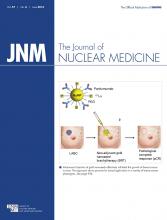REPLY: We appreciate the thoughtful comments of Dr. Van den Wyngaert about our paper entitled “Prognostic Factors in Patients Treated with 223Ra: The Role of Skeletal Tumor Burden on Baseline 18F-Fluoride PET/CT in Predicting Overall Survival” (1). As the title indicates, the purpose of the article was to retrospectively evaluate our extensive clinical experience with radium therapy in order to identify any patient-specific factors that—by being shown to correlate with overall survival—might give prognostic information.
It may be useful to frame the question from a clinical perspective. The quandary faced routinely by clinicians and nuclear physicians is whether a particular patient is likely to benefit from treatment with 223Ra. To answer this question comprehensively, several approaches will be needed. As Dr. Van den Wyngaert correctly notes, the ideal methodology to determine whether a particular patient cohort should receive radium therapy as opposed to an alternative therapy would be a prospective randomized trial. Such a framework might identify particular patient characteristics and biomarkers that correlate specifically with a positive response to a particular treatment and thus can be used to make decisions on the best course of therapy on a patient-by-patient basis.
Studies will need to be formulated and conducted in order to answer the question of predictive biomarkers. An entirely different question, however, is whether a particular patient has a high-enough expectation of surviving radium treatment to justify embarking on a 5-mo course of therapy, with its associated costs and ancillary procedures. What we noted in our experience was that not all patients respond well to radium and that some, in fact, cannot complete the full course of radium therapy because of events such as disease progression, toxicity, and death. Therefore, the fundamental question that drove this current investigation was whether there were particular patient characteristics we could identify and quantify that would tell us which patients were likely to complete therapy versus which were not. Our analysis found a significant correlation between the extent of disease quantified on the baseline 18F-fluoride PET/CT scan and overall survival.
To our knowledge, our paper was the first to report an independent prognostic biomarker of survival in prostate cancer patients undergoing treatment with 223Ra. No laboratory examination had been shown to be independently capable of evaluating outcome after 223Ra (as stated in our recent publication) (2,3), and no 18F-fluoride PET/CT imaging study on these patients was conducted before ours. We are cautious with our conclusions, however, and make no claim that 18F-fluoride PET/CT should be used to exclude patients from a treatment that has been shown to be very effective for bone-metastatic prostate cancer. Rather, our study provides a perspective on the clinical experience and outcomes in a busy radium practice that we hope will stimulate colleagues such as Dr. Van den Wyngaert to initiate further investigations that build on this knowledge.
A final issue that deserves clarification is that of guarantee-time bias and time-varying covariates. We agree that, technically, the number of doses is a time-varying covariate because it is not known at the start of the survival time. However, it does become known within the first 6 mo of survival or sooner. Guarantee-time bias occurs even in clinical trials and thus is not limited to observational data, as indicated in the critique cited by Dr. Van den Wyngaert (4).
The argument regarding “being able to receive an additional treatment cycle is conditioned on having survived…until that time point” does not apply in this case, since patients were still in the study after discontinuing 223Ra and patients whose disease progressed could continue to receive additional 223Ra doses. When our data are analyzed with the inclusion of time-varying covariate analysis, again interrogating the association between total number of 223Ra doses and overall survival, the data are consistent. The conclusions are also consistent, with no significant difference in the observed associations with overall survival or progression-free survival.
In conclusion, 18F-fluoride PET/CT is a novel prognostic imaging biomarker in men with metastatic castrate-resistant prostate cancer receiving 223Ra. Although this was a retrospective analysis and had the limitations inherent in such an analysis, we hope that our conclusions spark further investigations into the role of 18F-fluoride PET/CT (and other imaging studies) in patients with metastatic prostate carcinoma for whom therapy is being considered. The conclusions of our article remain the same even when one accounts for guarantee-time bias, and we believe that 18F-fluoride PET/CT may be as robust an imaging biomarker as 18F-FDG PET/CT in certain tumor types. We have now set the stage for further work with 18F-fluoride PET/CT, and we hope that our preliminary work will lead to prospective, more detailed investigations.
Footnotes
Published online Apr. 14, 2016.
- © 2016 by the Society of Nuclear Medicine and Molecular Imaging, Inc.







